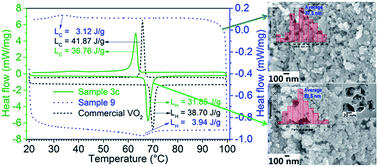Solution-based fabrication of VO2 (M) nanoparticles via lyophilisation
Abstract
Thermochromic vanadium dioxide (VO2) is the most extensively researched smart material owing to its near room-temperature phase transition at around 68 °C. Freeze drying has been employed in the solution-based fabrication of highly pure and crystalline VO2 nanoparticles and it was found that freeze drying can largely eliminate the agglomeration issue which is common in nanoparticle fabrication. The particle size, phase transition temperature (τc), crystallinity and latent heat (LH) have been systematically studied by changing the precursor concentration and annealing temperature. The freeze-dried sample (with 7.5 mL H2O2 in precursor) annealed at 650 °C has a particle size of ∼53 nm and τc of 64.5 °C, as well as high crystallinity with LC of 36.76 J g−1.


 Please wait while we load your content...
Please wait while we load your content...